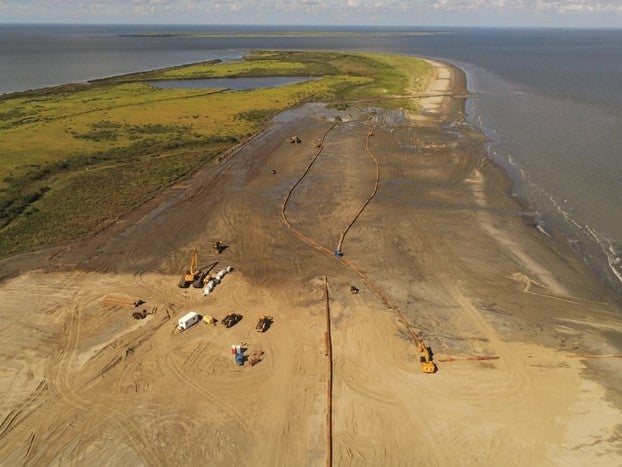Coastal Restoration is More Important Than Ever for Communities Across Louisiana’s Central Coast
This is the second blog in a series focused on coastal restoration projects advancing across Louisiana’s coast. You can read the Southeast blog here, and the Southwest Coast blog here.
As communities across Louisiana continue to recover from the devastation of the last two hurricane seasons, it’s difficult to think that another hurricane season is about to begin.
In 2020, five storms made landfall in Louisiana – the most ever – with Hurricanes Laura and Delta devastating the southwest portion of the state and Hurricane Zeta damaging areas from Port Fourchon to New Orleans.
In 2021, Hurricane Ida was one of the strongest hurricanes to ever make landfall in Louisiana and particularly impacted communities across Louisiana’s central coast including Terrebonne and Lafourche Parishes.
As devastating as that storm was, leaders at Louisiana’s Coastal Protection and Restoration Authority (CPRA) indicated that the damage would have been significantly worse without prior investments in coastal restoration and protection.
Experts already predict an above average hurricane season this year. Louisiana leaders must continue to advance critical coastal restoration projects that can provide a natural speedbump from storm surge for communities and help relieve pressure on levees and other structural solutions.
Thankfully, Louisiana released its largest Coastal Annual Plan ever to invest $1.3 billion in coastal projects over the next year and $3.5 billion over the next three years.
These investments will help the state continue its impressive coastal work, which currently includes 114 active projects with 76 in construction. The State has been strategic in leveraging federal funding from sources like NFWF, RESTORE, and NRDA to implement large-scale projects on the landscape. These efforts will build and maintain land to protect communities and help preserve the cultural and economic significance of this region.
Beyond storm surge, the Terrebonne Basin is experiencing rapid subsidence, sediment starvation, saltwater intrusion and relative sea level rise that is wiping land off the map and pushing the Gulf of Mexico further north toward population centers. Meanwhile, the neighboring Atchafalaya Basin is one of the few places on Louisiana’s coast actively gaining land because there is a connection between the Atchafalaya and Red Rivers and nearby wetlands. Scientists have termed this phenomenon “A Tale of Two Basins,” and it provides insight into the restoration solutions available to help build and maintain wetlands across the central coast.

CPRA used 3 million cubic yards of sediment to restore 530 acres on West Grande Terre barrier island (pictured above) in 2021. Over the last several decades, around 40 barrier islands and barrier island systems have been restored across Louisiana’s coast as a first line of defense and natural speedbump. Photo Credit: CPRA
These include a number of project types in this region such as the Terrebonne Basin Ridge and Marsh Creation – Bayou Terrebonne Increment and Bayou Dularge Ridge and Marsh Creation projects. In addition, restoration of three barrier islands is underway as part of the Terrebonne Basin Barrier Island project. Barrier islands provide a first line of defense from hurricanes and storm surge and are crucial to helping protect communities in Terrebonne Basin.
Other significant projects include the Houma Navigation Canal Lock Complex (HNC). This is a large-scale hydrologic restoration project currently under construction for the first of three phases. As this phase of dredging continues, project managers anticipate going to bid and construction on Phase II consisting of the lock complex in early 2023. This project, in addition to creating 178 acres of marsh along the northern portions of the navigation channel, will work with the rest of the Morganza to the Gulf Hurricane Protection System to protect Terrebonne and Lafourche parishes against storm surge and saltwater intrusion.
Another vital project is the Increase Atchafalaya Flow to Terrebonne Marshes, a freshwater diversion currently in the early stages of engineering and design. It will add sediment and freshwater into the degrading Terrebonne’s marshes and is anticipated to build and maintain 13,000 acres over 50 years This project will hopefully move into design this year and receive additional funding to continue implementation toward construction.
Coastal planners use a toolbox of different projects to address land loss and restore the coastal wetlands. Projects are more effective when they can work together, and it’s important that a variety of project types are moving forward across Louisiana’s central coast to provide multiple lines of defense from storm surge and coastal flooding. By implementing marsh creation, ridge restoration, barrier islands, freshwater diversions and hydrologic restoration projects, communities along the central coast will be better protected. We look forward to seeing even more projects and innovative ideas in this region when the 2023 Coastal Master Plan is released.